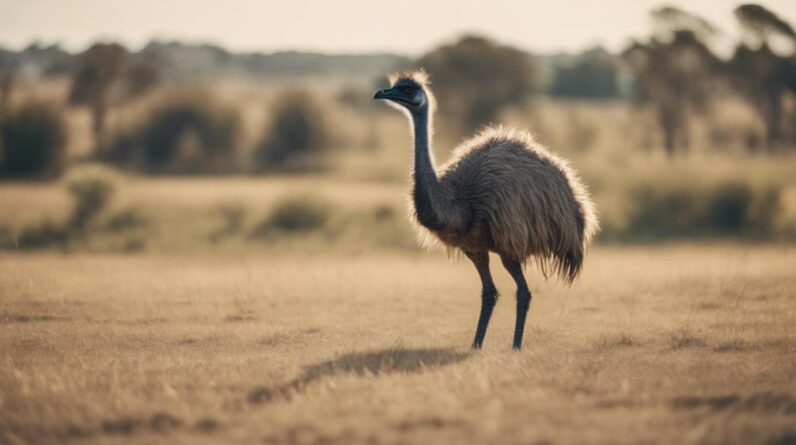
You've probably heard some wild stories about emus, like the classic tale of them burying their heads in the sand when danger looms. But did you know that these fascinating birds have a whole other side to their behavior? It's time to separate fact from fiction and uncover the truth behind emu myths. Let's shed light on their intriguing behaviors and dive deeper into the real world of emus.
Key Takeaways
- Emus do not bury their heads in the sand; they confront threats actively.
- Emus are not aggressive by nature but may chase when feeling threatened.
- Emus have small eyes, limited color vision, and excellent night vision.
- Emus use booming sounds in mating calls, not for burying their heads.
- Emus are intelligent, problem-solving birds with cooperative behaviors.
Emus Can't Walk Backwards
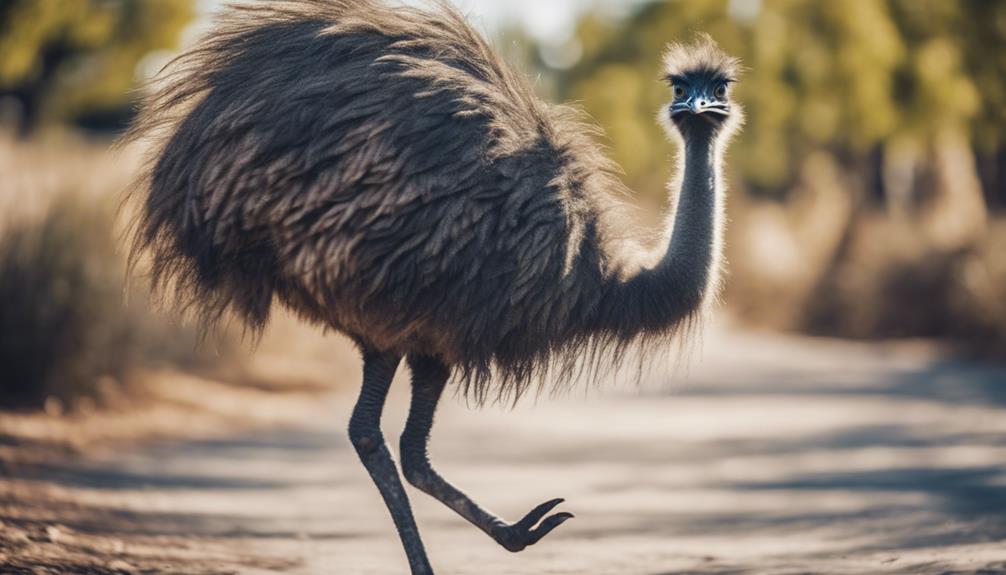
Contrary to popular belief, emus are physically capable of walking backwards when necessary. These flightless birds, known for their powerful legs and fast running speeds, exhibit a remarkable range of motion that includes the ability to move in reverse. Emus possess a unique skeletal structure and musculature that enable them to navigate various terrains with agility, whether moving forward or backward.
The emu's hind limbs are well-suited for both forward and backward movement, providing them with flexibility in their locomotion. Their strong leg muscles and joint articulation allow for precise control over their movements, making walking in reverse a feasible and practical option for these birds. While emus may not frequently walk backward in their natural environment, they can do so when the need arises, showcasing their adaptability and physical prowess.
Emus Are Aggressive Towards Humans
Emus' behavior towards humans is often misunderstood, with misconceptions about their aggression prevalent in popular discourse. Despite their large size and powerful legs, emus are not inherently aggressive towards humans. In fact, when left undisturbed, emus are rather docile creatures. However, they can exhibit defensive behaviors if they feel threatened or cornered. Understanding how to interact with emus can help prevent any potential conflicts. Below is a table outlining common misconceptions about emus' aggression towards humans:
| Misconception | Fact | Explanation |
|---|---|---|
| Emus attack humans unprovoked | Emus usually only attack when provoked | Emus may feel threatened and act defensively |
| Emus chase humans for no reason | Emus may chase if they feel threatened | Chasing is a defensive behavior |
| Emus are always aggressive towards humans | Emus are generally docile | Aggression is a response to perceived threats |
Understanding the nuances of emu behavior can help promote peaceful interactions between humans and these fascinating birds.
Emus Bury Their Heads in the Sand
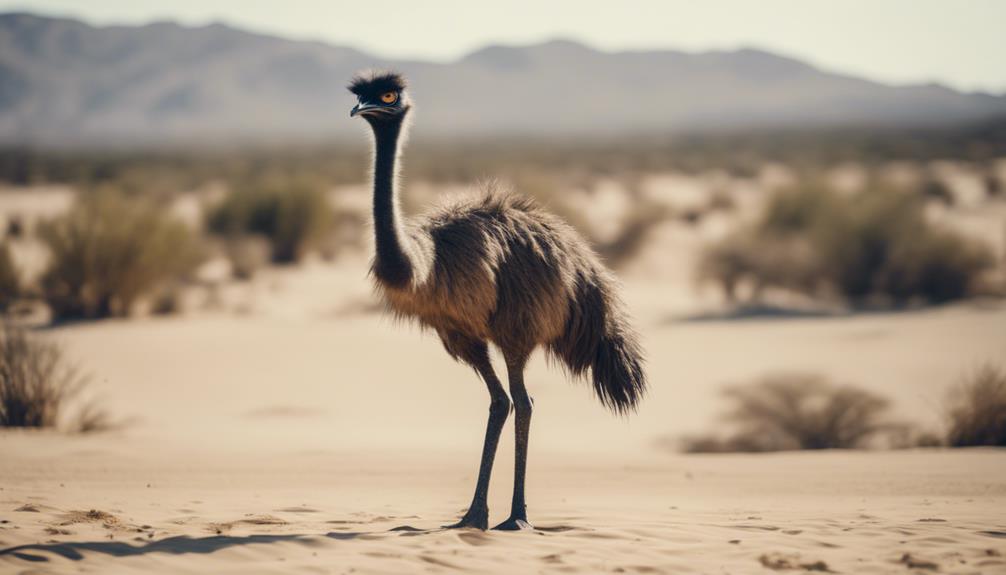
Emus don't actually bury their heads in the sand as commonly believed in popular culture. This myth likely stems from the behavior of ostriches, which don't bury their heads entirely but may appear to do so when they crouch low to protect their eggs. Emus, however, don't exhibit this behavior.
Emus are large flightless birds native to Australia, known for their distinctive appearance and powerful legs. Their behavior is rooted in survival instincts honed over centuries of evolution. When faced with danger, emus are more likely to run away or confront the threat head-on rather than attempting to hide. This is a strategic response to protect themselves and their young from potential harm.
It is essential to dispel misconceptions about emu behavior to appreciate these remarkable creatures fully. By understanding the truth behind their actions, we can better respect and coexist with these fascinating birds. Emus' instincts are finely tuned to their environment, allowing them to thrive in the harsh Australian landscape.
Emus Have a Low Intelligence
Despite common misconceptions, the intelligence of emus is often underestimated in relation to their survival strategies and adaptation to their environment. Emus exhibit remarkable problem-solving skills when faced with obstacles. They can navigate complex terrains, remember food sources, and recognize individuals within their social groups. Studies have shown that emus possess strong cognitive abilities, enabling them to learn quickly and exhibit curiosity towards novel stimuli.
Emus display a high level of emotional intelligence, as evidenced by their ability to communicate through various vocalizations and body language. They form strong bonds with their offspring and exhibit cooperative behaviors within their groups. Emus are also adept at assessing risks in their environment, displaying caution when encountering potential threats.
Furthermore, emus demonstrate flexibility in their behaviors, adjusting their foraging techniques based on food availability and environmental conditions. Their intelligence is evident in their ability to adapt to changing circumstances, showcasing a level of cognitive complexity that's often overlooked. Emus' intelligence plays a vital role in their survival and success in their natural habitat.
Emus Only Eat Plants
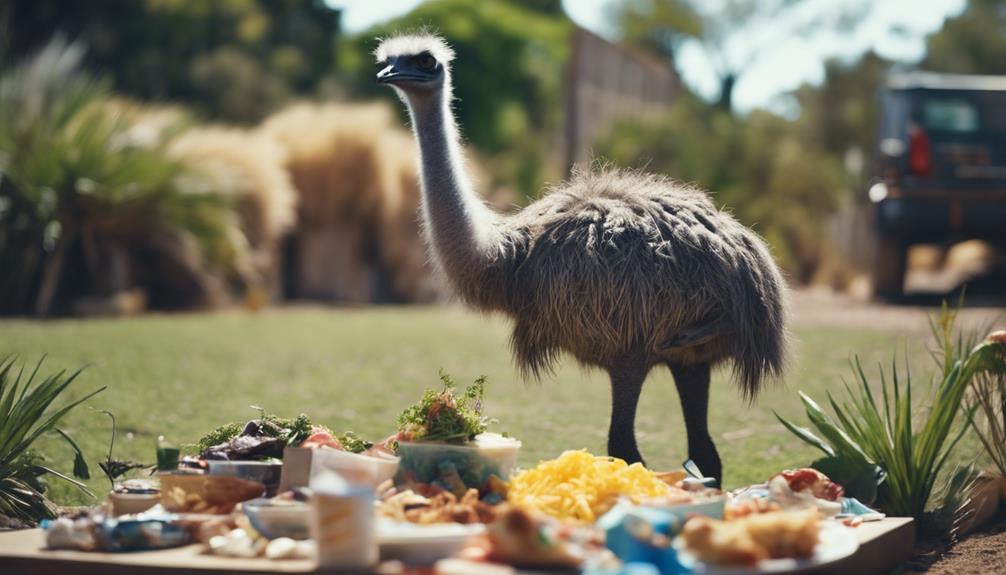
A significant aspect of emu dietary habits includes the consumption of various plant materials to meet their nutritional requirements. Emus are herbivores, primarily feeding on a wide range of plants such as fruits, seeds, leaves, and grasses. While it's true that emus predominantly eat plants, they are opportunistic feeders and may occasionally consume insects or small animals.
To provide a clearer understanding of the plant materials that emus consume, below is a table detailing some of the common plants in an emu's diet:
| Plant Type | Examples | Benefits |
|---|---|---|
| Fruits | Berries, apples | Rich in vitamins and antioxidants |
| Seeds | Sunflower seeds, grains | Good source of fats and proteins |
| Leaves | Spinach, kale | High in fiber and essential nutrients |
| Grasses | Timothy grass, clover | Provides carbohydrates and roughage |
| Vegetables | Carrots, cucumbers | Supply vitamins, minerals, and hydration |
Emus have adapted to thrive on a plant-based diet, utilizing a variety of vegetation to maintain their health and energy levels effectively.
Emus Are Solitary Birds
Among avian species, emus exhibit a predominantly solitary behavior pattern in their natural habitats. Emus are known to roam vast distances alone, foraging for food and taking care of their territories. This behavior is believed to be linked to their evolutionary adaptation to the harsh Australian outback environment. Emus tend to be territorial birds, and they're rarely seen forming social groups except during the breeding season.
In their solitary lifestyle, emus display a remarkable level of self-sufficiency. They're adept at finding food sources independently, such as fruits, seeds, insects, and plants. This behavior allows them to minimize competition for resources and reduce the risk of predation. Emus are highly vigilant creatures, constantly scanning their surroundings for potential threats while on their solitary journeys.
Emus Can't Swim

Emus, as a species, lack the innate ability to swim due to their anatomical characteristics and evolutionary adaptations. Despite their large size and powerful legs for running, swimming isn't a skill they possess. Here are some reasons why emus can't swim:
- Buoyancy: Emus have a dense body composition, which makes them sink rather than float in water. Their bodies aren't naturally buoyant like those of water-adapted birds.
- Leg Structure: The emu's legs, while excellent for running and agility on land, aren't designed for effective propulsion in water. Their short, sturdy legs aren't conducive to efficient swimming movements.
- Body Shape: The body shape of an emu, with a long neck and torso, isn't streamlined for swimming. Unlike aquatic birds with sleek, hydrodynamic bodies, emus would struggle to move effectively through water due to their bulkier build.
These factors combined make swimming a challenging and unnatural activity for emus, reinforcing the fact that they're land-dwelling birds.
Emus Have Poor Eyesight
With their evolutionary adaptations and habitat preferences, emus demonstrate limitations in their visual acuity. Emus have relatively small eyes compared to the size of their bodies, which impacts their ability to see long distances clearly.
The structure of their eyes is adapted for detecting movement rather than fine details, making them more attuned to spotting predators or prey in motion rather than stationary objects. Additionally, emus have a limited range of color vision, primarily perceiving shades of grey and some muted colors. This restricted color perception is a result of their habitat and evolutionary history, where the ability to differentiate colors wasn't as crucial for survival.
Despite these limitations, emus have excellent night vision, allowing them to forage and move around in low light conditions. Overall, while emus may not have the sharpest eyesight compared to some other bird species, their visual abilities are well-suited to their natural environment and behaviors.
Emus Make a Booming Sound
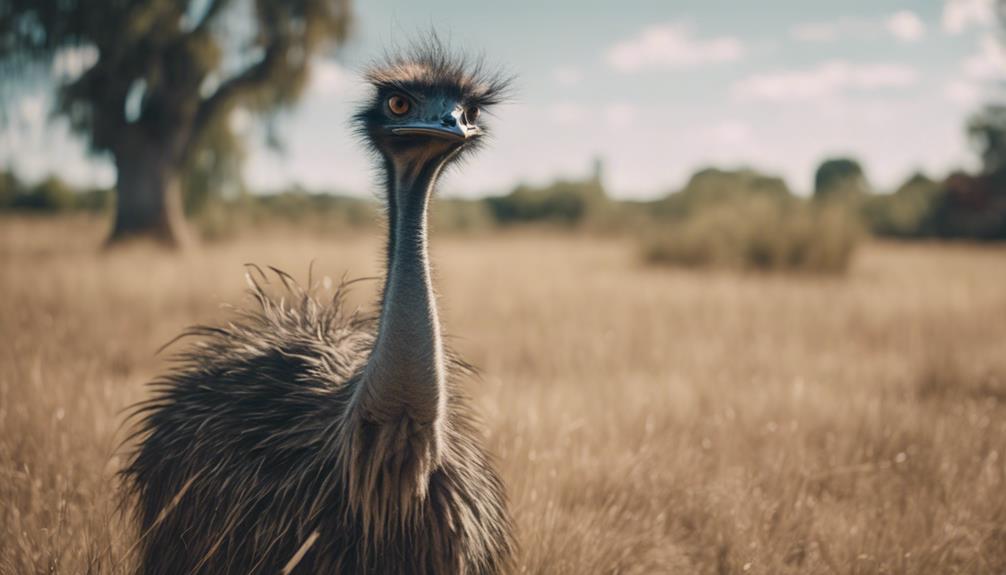
Emus produce a distinctive low-frequency vocalization known as a booming sound during their breeding season. This sound is primarily created by the male emus, who use it to attract females and establish their territory.
Here are some key points about emus making booming sounds:
- Purpose: The booming sound serves as a mating call, signaling the male emu's readiness to breed and attracting females for courtship.
- Sound Characteristics: The booming sound is deep and resonant, carrying over long distances due to its low frequency. It's created by inflatable neck sacs that the male emus use to amplify the sound.
- Behavioral Significance: The booming sound is a crucial part of the emus' breeding behavior, playing a significant role in their reproductive success. The louder and more impressive the booming sounds, the more likely a male emu is to attract a mate.
Understanding the significance of these booming sounds sheds light on the complex and fascinating behaviors of emus during their breeding season.
Emus Have Predatory Behavior
Predatory behavior is a notable aspect of the hunting strategies employed by emus in their natural habitat. Emus, despite their seemingly docile appearance, exhibit behaviors that are essential for their survival and dominance in the ecosystem. These flightless birds are opportunistic predators, preying on a variety of insects, small mammals, reptiles, and even birds. Their predatory nature is finely tuned, allowing them to efficiently locate, pursue, and capture their prey.
To understand the predatory behavior of emus better, let's delve into the key characteristics that define their hunting strategies:
| Predatory Behavior Characteristics | Description |
|---|---|
| Opportunistic Feeding | Emus exploit various food sources, adapting their diet based on availability and opportunity. |
| Efficient Pursuit | Emus use their powerful legs to chase down prey, displaying remarkable speed and agility. |
| Cooperative Hunting | Emus sometimes hunt in pairs or small groups, utilizing teamwork to increase hunting success. |
| Strategic Ambush | Occasionally, emus employ stealth and patience to ambush unsuspecting prey. |
| Selective Predation | Emus exhibit selectivity in their choice of prey, targeting species that align with their dietary needs. |
Emus Have a Short Lifespan
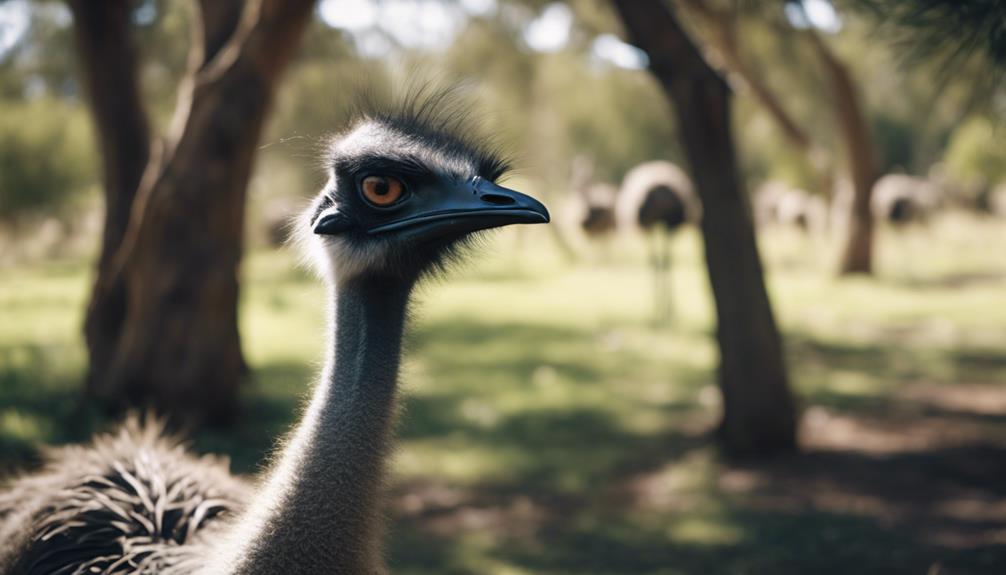
One notable aspect of emus' biology is their relatively short lifespan compared to other large bird species. Emus typically live for around 10 to 20 years, with some individuals in captivity reaching up to 35 years. This lifespan may seem short when compared to other large birds like the ostrich, which can live up to 40-45 years, or the albatross, known to live over 50 years. However, several factors contribute to the emu's lifespan:
- Predation: Emus face threats from predators such as dingoes, eagles, and feral cats, which can significantly reduce their lifespan in the wild.
- Environmental Conditions: Harsh environmental conditions, including droughts and bushfires, can impact the availability of food and water, affecting the emus' overall health and survival.
- Reproductive Stress: Emus invest a significant amount of energy into reproduction, with females laying large eggs and both parents sharing nesting duties. This reproductive effort can take a toll on their health and longevity.
Emus Are Endangered Species
An assessment of the current conservation status reveals the need to address the endangered status of emus. Emus, scientifically known as Dromaius novaehollandiae, aren't currently classified as endangered. The International Union for Conservation of Nature (IUCN) Red List categorizes them as a species of 'Least Concern.' This classification is due to the relatively stable population of emus in their natural habitat in Australia. Emus are resilient birds with a wide distribution across the continent, adapting well to various environments from forests to grasslands.
However, despite their current status, emus face certain threats that could potentially endanger their population in the future. Habitat loss due to human activities such as agriculture, urban development, and infrastructure expansion poses a significant risk to emus. Climate change and its associated impacts on food availability and nesting sites also present challenges to the long-term survival of emu populations. Monitoring and conservation efforts are crucial to ensure that emus remain a thriving species in the wild.
Frequently Asked Questions
Do Emus Make Good Pets?
Emus do not make good pets. They require specialized care, large living spaces, and can become aggressive. Emus are wild animals with specific needs unsuitable for domestication. Consider these factors before attempting to keep one as a pet.
Can Emus Be Trained to Do Tricks?
Yes, emus can be trained to do tricks. With patience, consistent training, and positive reinforcement, emus can learn to perform various tricks such as fetching objects, responding to commands, and interacting with their environment in specific ways.
Are Emus Related to Ostriches?
Despite similarities, emus and ostriches belong to different genera. Emus are part of the Dromaius genus, while ostriches fall under the Struthio genus. Both are large flightless birds, but they are not closely related.
Do Emus Have Any Natural Predators?
Emus have few natural predators due to their size and speed. Dingoes and wedge-tailed eagles pose threats to emu chicks. However, adult emus face minimal predation in the wild, relying on their agility to evade danger.
How Fast Can Emus Run?
Emus can run at speeds of up to 30 miles per hour, making them one of the fastest land birds. Their powerful legs and light build allow for impressive agility and swift movement across their habitat.
Conclusion
In conclusion, it's evident that many myths surround emu behavior, but the facts paint a different picture. Emus aren't aggressive by nature, but rather exhibit defensive behaviors when threatened. They don't bury their heads in the sand and are known for their confrontational nature.
Emus are intelligent birds that display a range of behaviors, including vocalizations and foraging for food. Understanding the true characteristics of emus is crucial to appreciating these unique and fascinating creatures in their natural habitat. As the saying goes, 'Don't judge a book by its cover.'





